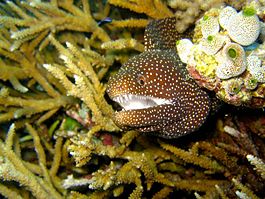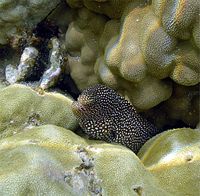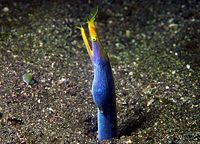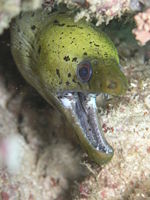Moray eel
| Moray eel | ||||||||||||
|---|---|---|---|---|---|---|---|---|---|---|---|---|
 | ||||||||||||
| Scientific classification | ||||||||||||
| ||||||||||||
|
See text. |
Moray eel is the common name for any of the marine eels comprising the family Muraenidae of the order Anguilliformes. They are characterized by an elongated, snake-like body, the absence of pectoral fins, a posterior nostril set high in the head, the lateral line pores on the head but not the body, and usually by long, fanglike teeth (Nelson 1994). Moray eels are the only known animal that uses a second set of jaws with pharyngeal jaws in capturing prey (Mehtal and Wainwright 2007). There are about 200 species in 15 genera.
Moray eels are cosmopolitan, found in tropical and temperate seas, although some species may be found in or occasionally enter freshwater (Nelson 1994).
While the fierce-looking moray eels can strike fear in the hearts of those people in their environment, and their bite can be painful and cause infection, they tend to be shy and secretive. A more common danger for humans is that presented when they are eaten, for some species (such as Gymnothorax) have been known to cause ciguatera fish poisoning. The toxicity actually is traced to certain micro-algae and other microorganisms, with the toxin (ciguatoxin) making it up the food chain to these carnivorous eels (Nelson 1994).
The danger that moray eels present is small relative to the benefit they bring to their ecosystems, helping to keep in balance their prey populations of fish and invertebrates (cephalopods, mollusks, and crustaceans) while being prey for a few predators, mainly groupers, other morays, and barracudas. For humans, their unique form, behavior, as well as colors and color patterns, adds to the wonder and mystery of nature.
Overview and family characteristics
Eel is the common name for any of the various members of the fish order Anguilliformes, which are characterized by an elongated, snake-like body, the absence of pelvic fins, and typically without scales or with the scales embedded in the skin. The dorsal and anal fins are long, usually connecting with the tail (caudal) fin, and the caudal fin lacks rays or may be absent. While the scales are usually absent, if they are present they are cycloid and embedded in the skin.
The flat and transparent larva of the eel is called a leptocephalus. A young eel is called an elver. Morphologically, the leptocephali larva of anguilliforms often differ considerably from the adults, to the extent that it is difficult to determine which leptocephali are the young of which adult (Nelson 1994).
The moral eels comprise one family within the Anguilliformes, the family Muraenidae. Other families include Anguillidae (freshwater eels), Chlopsidae (false morays), Moringuidae (spaghetti eels), Synaphobranchidae (cutthroat eels), Ophichthidae (snake eels and worm eels), Congridae (conger eels), Nemichthyidae (snipe eels), among others.
What distinguishes the moral eels, family Muraenidae, are such characteristics as having lateral line pores on head but not on body and the absence of pectoral fins; while some other eels lack the pectoral fin, only the moray eels have the pectoral fin also greatly reduced in the larval stage (Nelson 1994). Other characteristics include the restriction of the gill openings to small, roundish lateral openings, two branchial pores, and reduced gill arches (Nelson 1994). Most moray eels have long fang-like teeth (Nelson 1994).
Two subfamilies are recognized, Muraeninae and Uropterygiinae (Nelson 1994; ITIS 2004a). These are distinguished by the Uropterygiinae having ossified hypobranchials in the first and second arches, while the Muraeninae lack ossified hypobranchials, and the Uropterygiinae having vertical fins reduced and confined to the tip of the tail, while in the Muraeninae the vertical fins are not confined to the tip of the tail (Nelson 1994).
Anatomy
The dorsal fin of the moray extends from just behind the head, along the back, and joins seamlessly with the caudal and anal fins. The lack of pectoral and pelvic fins adds to the their snake-like appearance. Their eyes are rather small; morays rely on their highly developed sense of smell, lying in wait to ambush prey. Their small circular gills, located on the flanks far posterior to the mouth, require the moray to maintain a gape in order to facilitate respiration.
The body of the moray is patterned, camouflage also being present inside the mouth. Their jaws are wide, with a snout that protrudes forward. They generally possess large teeth, designed to tear flesh as opposed to holding or chewing. Morays are capable of inflicting serious wounds to humans.
The typical length of a moray is 1.5 meters (five feet), with the largest being the slender giant moray, Strophidon sathete, at up to four meters (13 feet).
Moray eels' heads are too narrow to create the negative pressure that most fish use to swallow prey. Moray eels have a second set of jaws in their throat called pharyngeal jaws, which also possess teeth. When feeding, morays launch these jaws into the oral cavity, where they grasp struggling prey and transport it into the throat and down to the rest of the digestive system. Moray eels are the only known type of animal that uses pharyngeal jaws to actively capture and restrain prey (Mehtal and Wainwright 2007; Hopkin 2007; NSF 2007).
Morays secrete a protective mucus over their smooth scaleless skin, with the mucus containing a toxin in some species. Morays have much thicker skin and high densities of goblet cells in the epidermis that allows mucus to be produced at a higher rate than in other eel species. This allows sand granules to adhere to the sides of their burrows in sand-dwelling morays (Fishelson 1996), thus making the walls of the burrow more permanent due to the glycosylation of mucins in mucus.
Behavior and feeding
Morays frequent tropical, warm waters, and subtropical coral reefs to depths of 150 meters, where they spend most of their time concealed inside crevices and alcoves.
Morays are carnivorous and feed primarily on other fish, cephalopods, mollusks, and crustaceans. Morays typically hide in crevices in the reefs, and wait until their prey is close enough for capture. They then lunge out and clamp the prey in their strong jaws. Groupers, other morays, and barracudas are among their few predators.
Morays tend to be solitary and nocturnal predators. Although they may ensnare small fish and crustaceans that pass near them during the day as they rest in crevices, they mostly come out at night (Bshary et al. 2006).
In the December 2006 issue of the journal, Public Library of Science Biology, a team of biologists announced the discovery of interspecies cooperative hunting involving morays (Choi 2006; Bshary et al. 2006). The biologists, who were engaged in a study of Red Sea cleaner fish (fish that enter the mouths of other fish to rid them of parasites), discovered that a species of reef-associated grouper, the roving coral grouper (Plectropomus pessuliferus), often recruited morays to aid them while hunting for food. This is the first discovery of cooperation between fish in general.
Morays have sometimes been described as vicious or ill-tempered. In fact, morays tend to be shy and secretive, and they are believed to only attack humans in self-defense. They also accidentally bite human fingers when being fed, because they cannot see or hear very well, although they have an acute sense of smell. Morays hide from humans and typically flee rather than fight. Morays, however, do inflict a nasty bite, because, although not poisonous, their backward-pointing teeth are covered with bacteria which may infect the wound.
Classification
The approximately 200 species of moray eels are commonly placed into two subfamilies, Uropterygiinae and Muraeinae. The following genera are arranged according to the Integrated Taxonomic Information System (ITIS 2004a, 2004b, 2004c).
- Subfamily Uropterygiinae
- Anarchias
- Channomuraena
- Cirrimaxilla
- Scuticaria
- Uropterygius
- Subfamily Muraeninae
- Echidna
- Enchelycore
- Enchelynassa
- Gymnomuraena
- Gymnothorax
- Monopenchelys
- Muraena
- Pseudechidna
- Rhinomuraena
- Strophidon
Nelson (1994) does not recognize Cirrimaxilla in Uropterygiinae, nor Pseudechidna in Muraeninae, but recognizes two other genera in Muraeninae, Thyrsoidea and Siderea. He places about 35 species in the subfamily Uropterygiinae and roughly 165 species in Muraeninae.
ReferencesISBN links support NWE through referral fees
- Bshary, R., A. Hohner, K. Ait-el-Djoudi, and H. Fricke. 2006. Interspecific communicative and coordinated hunting between groupers and giant moray eels in the Red Sea Plos Biology. Retrieved June 1, 2008.
- Choi, C. Q. 2006. An amazing first: Two species cooperate to hunt LiveScience. Retrieved June 1, 2008.
- Fishelson, L. 1996. Skin morphology and cytology in marine eels adapted to different lifestyles Anat Rec. 246(1):15-29. Retrieved June 1, 2008.
- Froese, R., and D. Pauly (eds.). 2006. Anguilliformes FishBase. Retrieved September 29, 2007.
- Hopkin, M. 2007. Eels imitate alien: Fearsome fish have protruding jaws in their throats to grab prey Nature News. Retrieved June 1, 2008.
- Integrated Taxonomic Information System (ITIS). 2004a. Muraenidae ITIS Taxonomic Serial No.: 161160. Retrieved June 1, 2008.
- Integrated Taxonomic Information System (ITIS). 2004b. Muraeninae ITIS Taxonomic Serial No.: 635303. Retrieved June 1, 2008.
- Integrated Taxonomic Information System (ITIS). 2004c. Uropterygiinae ITIS Taxonomic Serial No.: 635302. Retrieved June 1, 2008.
- Mehtal, R. S., and P. C. Wainwright. 2007. Raptorial jaws in the throat help moray eels swallow large prey Nature 449: 79-82. Retrieved June 1, 2008.
- National Science Foundation (NSF). 2007. Moray eels are uniquely equipped to pack big prey into their narrow bodies: Two sets of jaws capture and move prey to throat for swallowing National Science Foundation Sep. 5, 2007. Retrieved June 1, 2008.
- Nelson, J. S. 1994. Fishes of the World, 3rd ed. New York: John Wiley & Sons. ISBN 0471547131.
External links
All links retrieved June 1, 2025.
Credits
New World Encyclopedia writers and editors rewrote and completed the Wikipedia article in accordance with New World Encyclopedia standards. This article abides by terms of the Creative Commons CC-by-sa 3.0 License (CC-by-sa), which may be used and disseminated with proper attribution. Credit is due under the terms of this license that can reference both the New World Encyclopedia contributors and the selfless volunteer contributors of the Wikimedia Foundation. To cite this article click here for a list of acceptable citing formats.The history of earlier contributions by wikipedians is accessible to researchers here:
The history of this article since it was imported to New World Encyclopedia:
Note: Some restrictions may apply to use of individual images which are separately licensed.




